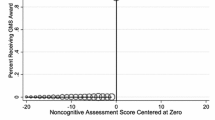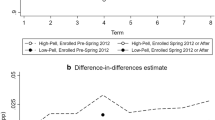Abstract
This longitudinal research study focused on persistence and financial aid of women, underrepresented minorities, and needy students majoring in science, engineering, and mathematics (SEM) in a large, public university in a metropolitan area. Beginning in fall 1989, four consecutive freshmen cohorts (n's = 1967, 1679, 1614, and 1924, respectively) were tracked through 1996–97. SEM majors persisted and graduated at higher rates, but took longer to graduate than non-SEM majors. Women, underrepresented minorities, and needy students received more gift aid than other student populations. However, only women had lower departure rates and graduated at higher rates than other SEM student populations. Compared to non-SEM majors, gift aid for SEM majors was more likely to be awarded on the basis of merit rather than need. Average loan indebtedness increased rapidly from 1989–90 through 1996–97 for both SEM and non-SEM majors. Implications of the findings for improved institutional and federal policy are indicated, and further research on the study topics recommended.
Similar content being viewed by others
REFERENCES
Astin, A. W. (1975). Financial Aid and Student Persistence. Los Angeles: Higher Education Research Institute.
Astin, A. W. (1982). Minorities in Higher Education: Recent Trends, Current Projects, and Recommendations. San Francisco: Jossey-Bass.
Astin, H. S., & Cross, P. H. (1979). Student Financial Aid and Persistence in College. Los Angeles: Higher Education Research Institute.
Brewton, D. L., & Hurst, E. E. (1984, October). A study of the attrition of beginning freshmen at a major urban university. Paper presented at the Annual Conference of the Southern Association for Institutional Research, Little Rock, AR.
Carroll, C. D. (1987). The Effects of Grants on College Persistence. Washington, DC: National Center for Education Statistics.
Cibak, M. A., & Chambers, S. L. (1991). Similarities and differences among Native Americans, Hispanics, Blacks and Anglos. National Association of Student Personnel Administrators Journal 28 (2): 129–139.
College Board. (1996). Trends in Student Aid: 1986 to 1996. New York: College Entrance Examination Board.
Elliott, R., Strenta, A. C., Adair, R., Matier, M., & Scott, J. (1995). Non-Asian minority students in the science pipeline at highly selective institutions. Unpublished grant report to the National Science Foundation.
Fenske, R. H., & Gregory, B. D. (1994). The dream denied? Evaluating the impact of student financial aid on low-income/minority students. In S. Hood and H. T. Frierson (eds.) Advances in Program Evaluation, Volume 2, pp. 141–160. Greenwich, CT: JAI Press.
Fenske, R. H., Porter, J. D., & Dillon, K. A. (1997). Studying the impact of federal changes at the campus level. In R. Voorhees (ed.), Financial Aid Issues, New Directions in Institutional Research Sourcebook, no. 95 (Fall), pp. 83–97. San Francisco: Jossey-Bass.
Gardner, P. D., & Broadus, A. (1990). Pursuing an Engineering Degree: An Examination of Issues Pertaining to Persistence in Engineering. East Lansing: Michigan State University Collegiate Employment Research Institute.
Goals 2000: Educate America Act. (1994). Public Law 103-227, 103rd Congress.
Government-University-Industry Research Roundtable. (1987). Nurturing science and engineering talent: A discussion paper. Washington, DC: National Academy of Science.
Landis, R. B. (1985). Handbook on Improving the Retention and Graduation of Minorities in Engineering. New York: The National Action Council for Minorities in Engineering.
Mestre, J. P. (1986). The Latino science and engineering student: Recent research findings. In M. A. Olivas (ed.), Latino College Students, pp. 157–192. New York: Teachers College Press.
Mortenson, T. G. (1989). Attitudes toward educational loans. Journal of Student Financial Aid 19 (3): 38–51.
National Center for Education Statistics. U. S. Department of Education. (1995). Minority Undergraduate Participation in Postsecondary Education. Washington, DC.
National Center for Education Statistics. U. S. Department of Education. (1996). The Condition of Education 1996. Washington, DC: U.S. Government Printing Office.
National Science Foundation. (1994). Women, Minorities, and Persons with Disabilities in Science and Engineering: 1994. Arlington, VA.
National Science Foundation. (1996). Women, Minorities, and Persons with Disabilities in Science and Engineering: 1996. Arlington, VA.
National Science Foundation. (1997). Characteristics of Recent Science and Engineering Graduates: 1995. Arlington, VA.
Nora, A. (1990). Campus-based aid programs as determinants of retention among Hispanic community college students. Journal of Higher Education 61 (3, May/June): 312–331.
Olivas, M. A. (1985). Financial aid packaging policies: Access and ideology. Journal of Higher Education 56 (4, July/August): 462–475.
Pascarella, E. T., & Terenzini, P. T. (1980). Predicting freshman persistence and voluntary dropout decisions from a theoretical model. Journal of Higher Education 51: 60–75.
Porter, J. D. (1986). Packaging influence on minority student financial aid eligibility: A policy impact analysis. Unpublished doctoral dissertation, Arizona State University.
Porter, O. F. (1990). Undergraduate Completion and Persistence at Four-Year Colleges and Universities. Washington, DC: The National Institute of Independent Colleges and Universities.
Regional Policy Committee on Minorities in Higher Education. (1987). From Minority to Majority. Boulder, CO: Western Interstate Commission for Higher Education.
Rendon, L. I. (1982). Chicano students in south Texas community colleges: A study of student and institution-related determinants of educational outcomes. Unpublished doctoral dissertation, University of Michigan.
Rendon, L. I., & Nora, A. (1988). Hispanic students: Stopping the leaks in the pipeline. Educational Record 68(4, Fall-Winter): 79–85.
Rendon, L. I., & Triana, E. M. (1989). Making Mathematics and Science Work for Hispanics. Washington, DC: American Association for the Advancement of Science.
St. John, E. P. (1989). The influence of student aid on persistence. Journal of Student Financial Aid 3 (Fall): 52–68.
St. John, E. P., & Noell, J. (1989). The effects of student financial aid on access to higher education: An analysis of progress with special consideration of minority enrollment. Research in Higher Education 30 (6, December): 563–581.
Steele, C. M. (1995). A burden of suspicion: How stereotypes shape the intellectual identities and performance of women and African Americans. Unpublished paper.
Strenta, A. C., Elliott, R., Adair, R., Matier, M., and Scott, J. (1994). Choosing and leaving science in highly selective institutions. Research in Higher Education 35 (5, October): 513–547.
Thomas, G. E. (1986). The Access and Success of Blacks and Hispanics in U.S. Graduate and Professional Education. A Working Paper. National Academy of Sciences-National Research Council, Washington, DC: National Research Council.
Author information
Authors and Affiliations
Rights and permissions
About this article
Cite this article
Fenske, R.H., Porter, J.D. & DuBrock, C.P. Tracking Financial Aid and Persistence of Women, Minority, and Needy Students in Science, Engineering, and Mathematics. Research in Higher Education 41, 67–94 (2000). https://doi.org/10.1023/A:1007042413040
Issue Date:
DOI: https://doi.org/10.1023/A:1007042413040




